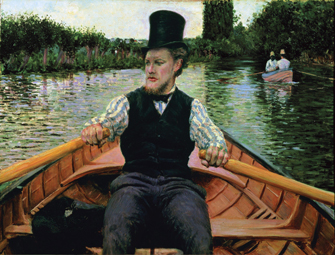
Gustave Caillebotte (French, 1848–1894). Oarsman in a Top Hat, 1877–78. Oil on canvas, 357⁄16 x 461⁄16 in. (90 × 117 cm). Private collection

Gustave Caillebotte (French, 1848–1894). Oarsman in a Top Hat, 1877–78. Oil on canvas, 357⁄16 x 461⁄16 in. (90 × 117 cm). Private collection
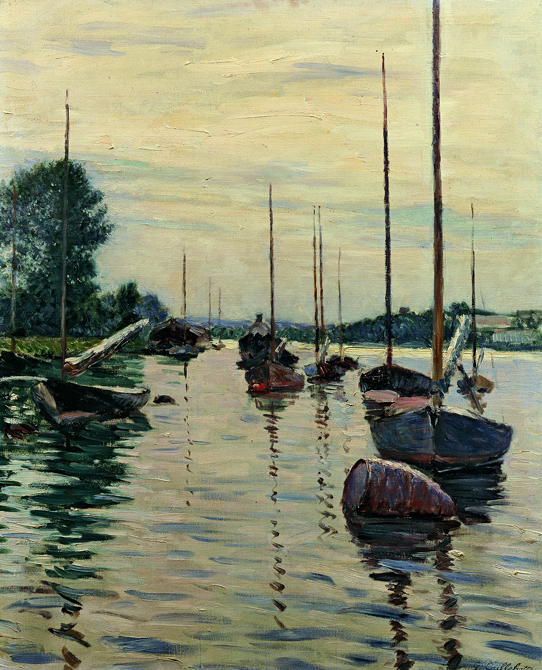
Gustave Caillebotte (French, 1848–1894). Boats Moored on the Seine, 1892. Oil on canvas, 283⁄4 x 235⁄8 in. (73 × 60 cm). Private Collection
At the Argenteuil basin, sailboats plied the waters alongside commercial barges and steamboats, making this waterway as diverse as the newly redesigned streets of Paris, where laborers crossed paths with top-hatted bourgeois. This image of unusual calm depicts both the swift sailboats in the foreground and the hulking barges just beyond at their moorings. As in his long views of the Parisian boulevards, Caillebotte shows a deep recession looking down the river, marked by diminishing masts. The artist dissolves the elegant lines and tall masts of the yachts in the shimmering reflections of the river’s surface, which are executed in thick strokes. At left, Caillebotte includes the Roastbeef, a boat of his own design.

Gustave Caillebotte (French, 1848–1894). Factories in Argenteuil, 1888. Oil on canvas, 259⁄16 x 325⁄16 in. (65 × 82 cm). Private collection

Gustave Caillebotte (French, 1848–1894). Roses in the Garden at Petit Gennevilliers, 1886. Oil on canvas, 351⁄16 x 4511⁄16 in. (89 × 116 cm). Private collection
Avidly interested in gardening—as well as painting and sailing—Caillebotte supervised the planting of elaborate gardens on his property at Petit Gennevilliers. In the 1890s, the painter corresponded about horticulture with his colleague and friend Claude Monet, who had likewise immersed himself in the cultivation of an extensive garden at his home in Giverny, a village on the Seine located about fifty miles from Paris. Normally associated with compositions featuring strict rectilinear recessions, Caillebotte here exploits the curved path to suggest depth. Although her face is turned away from the viewer, the woman has been identified as Charlotte Berthier, Caillebotte’s companion.
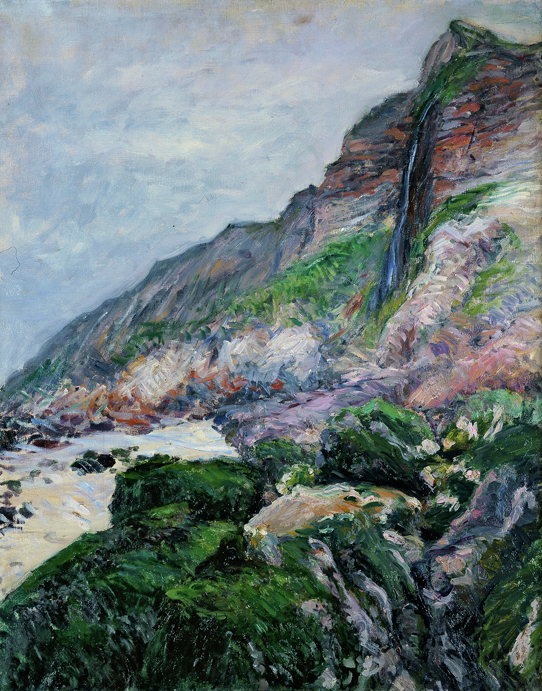
Gustave Caillebotte (French, 1848–1894). Cliffs in Normandy, 1880. Oil on canvas, 283⁄4 x 235⁄8 in. (73 × 60 cm). Private collection
Although most of Caillebotte’s Norman scenes offer an elevated vantage point, here he positions himself at beach level below the northern coast’s monumental cliffs. The artist uses a varied palette of warm ocher, rose, and salmon tones to capture the horizontal striations of the rock formations, as well as cooler greens, violets, and blues to paint the wild vegetation, the shadows cast by the gray cloud-filled sky, and the picturesque waterfall rushing from the brow of the cliff at the upper right. Close inspection of the surface of this canvas reveals grains of sand mixed into the paint, underscoring the artist’s practice of working in the open air—in this case, on the shore.
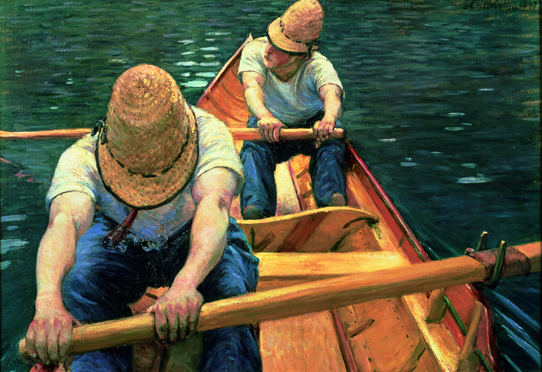
Gustave Caillebotte (French, 1848–1894). Oarsmen Rowing on the Yerres, 1877. Oil on canvas, 317⁄8 x 4511⁄16 in. (81 × 116 cm). Private collection
This scene of rowers displays one of the most daring perspectives employed by Caillebotte to this date. Reaching forward to place his blade in the water, the foreground oarsman almost seems to break through the picture plane. Whereas other boating scenes include lush renderings of the surrounding landscape, here Caillebotte narrows the field of vision, focusing solely on the rowers’ exertions and the water’s sparkling reflections.
Caricaturists made much of the unusual perspective that obscured the facial features of the rowers. One satirically joked that Caillebotte might assume the duties of the recently retired executioner, given his propensity for removing heads.
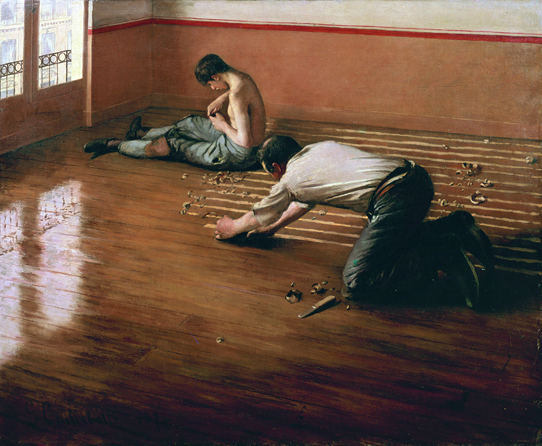
Gustave Caillebotte (French, 1848–1894). The Floor Scrapers, 1876. Oil on canvas, 311⁄2 x 393⁄8 in. (80 × 100 cm). Private collection
This is one of two paintings of urban laborers that established Caillebotte’s reputation at the second Impressionist exhibition in 1876. In this image, the two men—likely master and apprentice—finish a newly laid hardwood floor by shaving the buckling boards into plane. Research suggests that the space may have been Caillebotte’s own studio. While the older man passes his tool over the joins, leaving behind curled shavings, the boy pauses to sharpen his blade.
Anticipating his later open-air scenes, this painting reveals Caillebotte’s early explorations of light, water, and reflection (floor scrapers typically wet the boards to prevent splintering). At the left edge of the canvas, the strict geometries of the ironwork, reflected on the floor, dissolve into squiggles. Many conservative writers disliked such scenes of urban labor, but critics allied with the avant-garde applauded the subject drawn from daily life and identified Caillebotte as an emerging talent.
Gustave Caillebotte: Impressionist Paintings from Paris to the Sea
March 27–July 5, 2009
As a participant in the landmark retrospective exhibition that introduced Gustave Caillebotte to the American public in 1976–77, the Brooklyn Museum is proud to present Gustave Caillebotte: Impressionist Paintings from Paris to the Sea, the first major showing of the artist’s oeuvre in New York in over thirty years. In addition to the well-known Parisian cityscapes that have traditionally marked him as the “Urban Impressionist,” Caillebotte painted scenes of outdoor life away from the city on the coast of Normandy and in the villages of Yerres and Petit Gennevilliers, where he and his family maintained estates. The approximately forty paintings included in this focused thematic exhibition reveal Caillebotte’s extraordinary passion for subjects in which water plays a central role—as an enigmatic, magical element reflecting its surroundings, as an essential atmospheric ingredient, and as a scene for sporting activities. As a passionate rower and yachtsman, Caillebotte approached his motifs with the trained eyes and hand of an accomplished engineer and sportsman. The exhibition will also include drawings as well as models and sketches for the construction of Caillebotte’s sailboats.
Gustave Caillebotte: Impressionist Paintings from Paris to the Sea is organized by the Brooklyn Museum, Ordrupgaard, Copenhagen, and Kunsthalle Bremen. The exhibition is curated by Judith F. Dolkart, Brooklyn Museum, Dorothee Hansen, Kunsthalle Bremen, and Anne-Birgitte Fonsmark and Gry Hedin, Ordrupgaard.
The Brooklyn presentation is made possible by generous support from the Robert Lehman Foundation, the Brooklyn Museum’s Barbara and Richard Debs Exhibition Fund, and Martha A. and Robert S. Rubin Exhibition Fund. The Federal Council on the Arts and the Humanities has granted an indemnity for this project.

